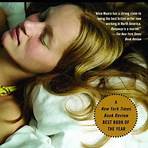
Discussed May 15, 2025
Report : Wendy H.
Wendy began her introduction to Munro and Runaway by saying that some of the biographical details that have recently come out about the author are as troubling and heart-wrenching as the stories in this collection. Munro relied on her experience and observations to nourish her writing, and she transforms the ordinary and sometimes sordid details of life into stories that deepen and complexify our sense of human existence.
Her childhood was spent on the fox farm run by her parents. Life was hard and the family was poor. She was often beaten, especially when she did something that was out of the ordinary. Her parents were anxious for their children to conform. One especially telling incident that she told her daughter was the memory of being beaten for giving names to the baby foxes on the farm.
Another thing that emerges is the difficulty she faced reconciling her roles as wife, mother, and writer. She had four daughters with James Munro (one died shortly after birth), and when the children were still young she would attempt to write whenever she could. Picture her writing on the kitchen table while the babies napped. Social expectations meant that she was seen first as a housewife and only incidentally as a writer. In 1961, after she had had a few stories published in small magazines, the Vancouver Sun ran a brief article on her, entitled "Housewife Finds Time to Write Short Stories.” Alice’s first husband was fairly supportive. He bought her a typewriter and when the Munro’s opened a bookstore, he would send her to the shop to write while he looked after the children and cooked. When Munro’s first book won the Governor-General’s Award in 1967, one of the Victoria papers headlined its story “Literary Fame Catches City Mother Unprepared.”
Alice divorced James Munro in the early 70s and later re-connected with a man she had desired in college, Gerald Fremlin. She moved in with him in 1975. The details about this relationship are extremely troubling. In fact, when I found out about it, I had to return to the stories and read them in a new light. Reading the stories the first time gave me a mixture of extreme pleasure in the skill with which they are told and pain at the quiet suffering the characters endure. Re-reading them in the light of the facts that have recently emerged heightened those feelings and made me feel pity and anguish not just for the characters but also for Munro and her daughters.
Apparently Fremlin made a habit of mocking and belittling Munro, who adored him and increasingly depended on him. Even more damning, he began a pedophiliac relation with Munro’s youngest daughter, Andrea, when she was 9 years old. As is often the case with victims of sexual abuse, Andrea didn’t speak openly about this until almost 20 years later.
Eventually, in 2005, she filed a complaint against Gerry Fremlin and he was convicted of sexual abuse. One of the pieces of evidence in the case was a letter he had written to Andrea justifying his behaviour.
Munro’s reaction to the knowledge is difficult to admit. In a letter to her agent and close friend after the conviction, she wrote:
Gerry is doing really well when you consider what a reversal and loss this had to be. Andrea’s okay, but doesn’t want to be in touch with me now G. is here. We’ll see — it’s still so raw. You never come out with the mended teapot looking like new and I guess you’re lucky if it holds the tea. (See how Ms. M. clings to the comfy domestic images.) […]
It’s clear from this letter that Fremlin came first, Andrea second. Andrea wrote that her mother
“said that she had been ‘told too late … {that} she loved him too much and that our misogynistic culture was to blame if I expected her to deny her own needs, sacrifice for her children and make up for the failings of men.”
The Canadian press didn’t publicise the story. Munro is considered a "national treasure" of Canada, practically as beloved as Queen Elisabeth. Munro’s biographer was told about the conviction in 2005, but chose not to mention it in the biography he published that year.
Wendy felt that Alice Munro’s family secrets—the violence she suffered as a child and the abuse of her daughter— could be the dross that her writing transforms into gold. In presenting her with the Noble Prize for literature, the Swedish Academy said:
Her short stories rely very little on external drama. They are an emotional chamber play, a world of silences and lies, waiting and longing. The biggest events occur inside of her characters. The greatest pain remains unexpressed. Like few others, she is interested in the silent and the silenced, the passive, those who choose not to choose, who live on the sidelines, the quitters and losers. ….
What resonates most with these stories and with Munro’s own shameful secret is the phrase those who choose not to choose. Her characters let things go. Even those who may seem strong avoid confrontation when a moment calls for action.
In “Runaway,” Carla goes back on her choice to leave Clark. And when she finds out about the lost little goat Flora reappearing on the night Carla runs away, she deals with the knowledge “as if she had a murderous needle somewhere in her lungs, and by breathing carefully, she could avoid feeling it.” (50). In “Silence” Juliet suffers but doesn’t make the effort to renew contact with her daughter. In “Tricks” Robin doesn’t seek an explanation for her reception in the clock shop. In “Powers” Nancy doesn’t confront Ollie about his lie concerning Tessa and she doesn’t try to track down her old friend afterwards.
We considered the question why Juliet doesn’t look for her daughter. One answer was that she has tortured herself with the idea that she has done something wrong.
Sealia felt that there was a lack of trust in the relationship, so that when Penelope was away at the time of Eric’s death, Juliet didn’t want to perturb her with the news. Caroline found it interesting that he has a pagan burial. If this is spiritual, it’s not Christian. Perhaps Penelope bears a grudge about that. Caroline found that Juliet has a strange relationship with death. She feels guilt that she wasn’t there at her mother’s death. We discussed the scene where Juliet argues with the priest at her mother’s bedside. Caroline found this revelatory of Juliet’s relationship with her mother. She doesn’t think of her mother’s feelings or beliefs because she wants so badly to affirm her atheism. Why is she so attracted by mythology? Is it a substitute for religion? Myths seem more important than human beings. Religion is a machine for producing guilt and Juliet doesn’t want to have anything to do with guilt, hence her rejection of the priest and of her daughter who needs religion. She wants her daughter to be free. She wonders if she have taught her prayers so that she could reject the false comfort of religion.
Denise pointed out that Penelope’s behaviour is strange. There’s really no reason given for her cutting off her mother. One suggestion was that perhaps Penelope is angry, for example because when Eric dies Juliet doesn’t tell her daughter immediately. In fact, we know nothing about Penelope’s life. Penelope is not a character. The stories in the Juliet trilogy are all told from Juliet’s point of view. She doesn’t think she has done anything wrong.
Munro leaves room for reader to explore such gaps in the stories. For Wendy (and others) this is the author’s genius. For Beth, it’s an abject failure. Caroline does not feel that Munro fails as a writer (however she may have failed her daughter Andrea). What distinguishes Munro is her gift for writing about ordinary people. Her characters are anti-heroes. They can’t cope with their feelings. The originality of the stories is clear in that we never quite know what will happen.
Even though characters may fail to act at key moments, when they do act “decisively” it’s often completely on the spur of the moment and not thought out. For example, Carla decides to leave her husband immediately after the conversation with Sylvia. Sylvia then pushes her once she says she would leave “now this minute” if she could.
In some cases we don’t know why they act the way they do. In “Silence” Why does Penelope break off contact with her mother? Why does she send birthday cards on the date of her own birth for five years and then stop? We never get her point of view and Juliet doesn’t speculate. This leaves a gap into which readers can plunge. So the Guardian review that came out when the book was published in 2004 speculates: “It turns out that the independence and rationalism we have admired in Juliet have alienated her child, who has left in search of the spiritual things she never had at home.” Beth thought that the author just lets things go. She doesn’t pursue her stories. She is not curious. But this was a minority view. Barb said she likes to read fiction that doesn’t tell everything. About the birthday cards, we found that it could be read as an act of cruelty, Penelope taunting Juliet. Or it could be an acknowledgment that Juliet is her mother, a recognition that she gave birth to her. Maybe the cards stopped when Juliet had her own children. But these are just some of the speculations that Munro’s stories provoke in readers.
The Swedish Academy called her a "master of the contemporary short story" who could "accommodate the entire epic complexity of the novel in just a few short pages.” One of the ways she does this is by juxtaposing a series of vignettes. She doesn’t fill in the blanks between scenes—it’s up to the reader to join up the dots. So we have to make an effort and also to accept that not everything will be explained or resolved. And in a way that’s what creates the sense of witnessing entire lives and gaining knowledge of characters.
Wendy quoted the critic Garan Holcombe who writes: "All is based on the epiphanic moment, the sudden enlightenment, the concise, subtle, revelatory detail.” The term “epiphany” is used by James Joyce to refer to a moment of revelation. Writers use such moments to create character development, to create a plot shift, or to provide a moment of illumination for either a character, the reader, or both. Characters may gain new understanding of themselves or of their situations. We then discussed epiphanies in the story collection.
Sylvia’s letter in “Runaway” could be a moment of epiphany, yet we don’t really know how much Carla understands about Flora. Then there’s the moment when Flora appears to Sylvia and Clark. What is revealed? The appearance of the goat resolves the conflict between Sylvia and Clark. And after that night, there is peace between Carla and Clark. It’s not stated what happens to Flora. Betsy wonders if Clark hid the goat. In our discussion though, we came to the conclusion that Clark had killed Flora. He exercises violence on the (scape)goat so as not to turn on the two women. Carla saw buzzards circling over the woods after the night of her return. Knowledge of her husband’s violence is probably the poisonous needle that she feels in her lungs.
In the Juliet trilogy, is the meeting with Penelope’s friend a kind of epiphany? But it’s not clear whether Juliet ever achieves understanding. There seems to be a blind spot in the story that might mirror Munro’s own situation and also the blankness that is at the heart of many accounts of family trauma.
Wendy admitted that she can’t help reading some details as efforts to distance, disguise and even deny the abuse going on in Munro’s own home. For example the fact that Carla’s story of abuse by Sylvia’s sick husband is pure invention. Some of the things in the story might make us think of Munro’s situation, for example when Clark says to Carla “Threaten to go to the papers. Big-time poet. The papers would eat it up. All we have to do is threaten and she’d cave in.” There’s also the fact that Juliet knows of no reason why Penelope should break off contact. It seems as if the daughter is abusive in that story, an inversion of Andrea’s story.
Art conceals and reveals at the same time. It may seem that the narrators in these stories are revealing something at key moments—they are—but there is always something left out, not stated. And there are elements that are encrypted in imagery. Although the language is not poetic— the stories convey each narrator’s idiomatic voice, rather ordinary in most cases—Munro leaves us with unexplained images that demand the kind of engagement needed when reading poetry.
The beginnings of the stories are intriguing. Often they begin at the end or in the middle of the events that unfold. We’re used to this device. So many films and series nowadays play with the ordering of events. The opening is like a hook that grabs you and makes you continue until the enigma is explained. There’s the couple watching out for Sylvia in “Runaway.” There’s the Chagall print in “Soon”. There’s the search for Traverses’ summer house in “Passion”. There’s the drive to a random location in a snowy landscape in “Trespasses”, the importance of the dress in “Tricks”. Some of these things will be explained, but others not really. For example, we can only speculate about why Juliet chooses the Chagall print for her parents.
We had an interesting discussion about the motives that make people write. Why did Munro write? Wendy argued that we all tell stories and they are governed by conventions about storytelling. But not everyone is a writer by any means. There’s a lot of work involved in learning the craft. Writers like Munro observe the social interactions around them and transform them into fiction.
Wendy finished with a question that we asked last month. Do French, British and American readers have the same reactions to the stories? How Canadian are the stories? The feeling of Canadian-ness comes (for some of us) from the descriptions of settings familiar from American culture—the proximity to wilderness, the haphazardness of settlements, the mess of some homes with their wrecked cars, children’s toys, broken objects all on display. The ways of being of certain characters are shaped by Anglo culture: The imperative of politeness, the reticence, communication by suggestion rather than declaration, the characters’ embarrassment in social situations. So much is implicit. Munro’s art lies partly in conveying the complicated codes of Anglo-Canadian culture.

